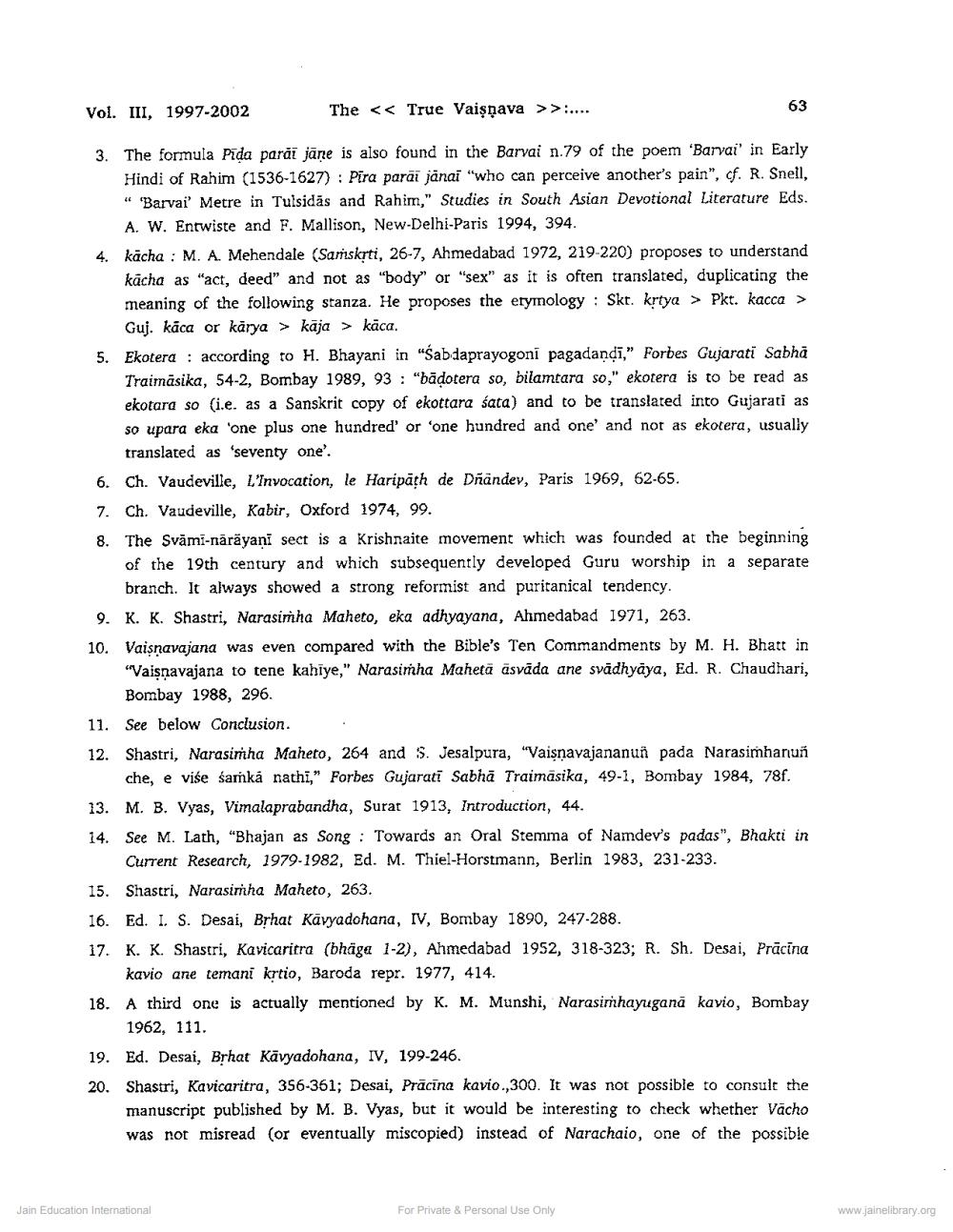Book Title: Jaina Heritage in Gujarat Author(s): Francoise Mallison Publisher: Z_Nirgrantha_1_022701.pdf and Nirgrantha_2_022702.pdf and Nirgrantha_3_022703.pdf View full book textPage 7
________________ Vol. III, 1997-2002 The << True Vaişnava >>.... 63 3. The formula Pīda parāi jāre is also found in the Barvai n.79 of the poem 'Barvai' in Early Hindi of Rahim (1536-1627): Pira paräi jänai "who can perceive another's pain", cf. R. Sneil, " 'Barvai' Metre in Tulsidas and Rahim," Studies in South Asian Devotional Literature Eds. A. W. Entwiste and F. Mallison, New Delhi-Paris 1994, 394. kācha : M. A. Mehendale (Samskrti, 26-7, Ahmedabad 1972, 219-220) proposes to understand kācha as "act, deed" and not as "body" or "sex" as it is often translated, duplicating the meaning of the following stanza. He proposes the etymology: Skr. krtya > Pkt. kacca > Guj. kāca or kārya > kāja > kāca. 5. Ekotera : according to H. Bhayani in "Sabdaprayogoni pagadandi," Forbes Gujarati Sabha Traimāsika, 54-2, Bombay 1989, 93 : "badotera so, bilamtara so," ekotera is to be read as ekotard so (i.e. as a Sanskrit copy of ekottara sata) and to be translated into Gujarati as so upara eka 'one plus one hundred' or 'one hundred and one and not as ekotera, usually translated as 'seventy one'. 6. Ch. Vaudeville, L'Invocation, le Haripāth de Dñandev, Paris 1969, 62-65. 7. Ch. Vaudeville, Kabir, Oxford 1974, 99. 8. The Svāmī-nārāyani sect is a Krishnaite movement which was founded at the beginning of the 19th century and which subsequently developed Guru worship in a separate branch. It always showed a strong reformist and puritanical tendency. 9. K. K. Shastri, Narasimha Maheto, eka adhyayana, Ahmedabad 1971, 263. 10. Vaisnavajana was even compared with the Bible's Ten Commandments by M. H. Bhatt in "Vaisnavajana to tene kahiye," Narasimha Mahetā āsvāda ane svādhyāya, Ed. R. Chaudhari, Bombay 1988, 296. 11. See below Conclusion. 12. Shastri, Narasimha Maheto, 264 and S. Jesalpura, "Vaisnavajananun pada Narasimhanun che, e viśe šamká nathi," Forbes Gujarati Sabhā Traimasika, 49-1, Bombay 1984, 78f. 13. M. B. Vyas, Vimalaprabandha, Surat 1913, Introduction, 44. 14. See M. Lath, "Bhajan as Song : Towards an Oral Stemma of Namdev's padas", Bhakti in Current Research, 1979-1982, Ed. M. Thiel-Horstmann, Berlin 1983, 231-233. 15. Shastri, Narasimha Maheto, 263. 16. Ed. I. S. Desai, Brhat Kävyadohana, IV, Bombay 1890, 247-288. 17. K. K. Shastri, Kavicaritra (bhäga 1-2), Ahmedabad 1952, 318-323; R. Sh. Desai, Pracina kavio ane temani krtio, Baroda repr. 1977, 414. 18. A third one is actually mentioned by K. M. Munshi, Narasimhayuganā kavio, Bombay 1962, 111. 19. Ed. Desai, Brhat Kävyadohana, IV, 199-246. 20. Shastri, Kavicaritra, 356-361; Desai, Pracīna kavio.,300. It was not possible to consult the manuscript published by M. B. Vyas, but it would be interesting to check whether Vacho was not misread (or eventually miscopied) instead of Narachaio, one of the possible Jain Education International For Private & Personal Use Only www.jainelibrary.orgPage Navigation
1 ... 5 6 7 8 9
